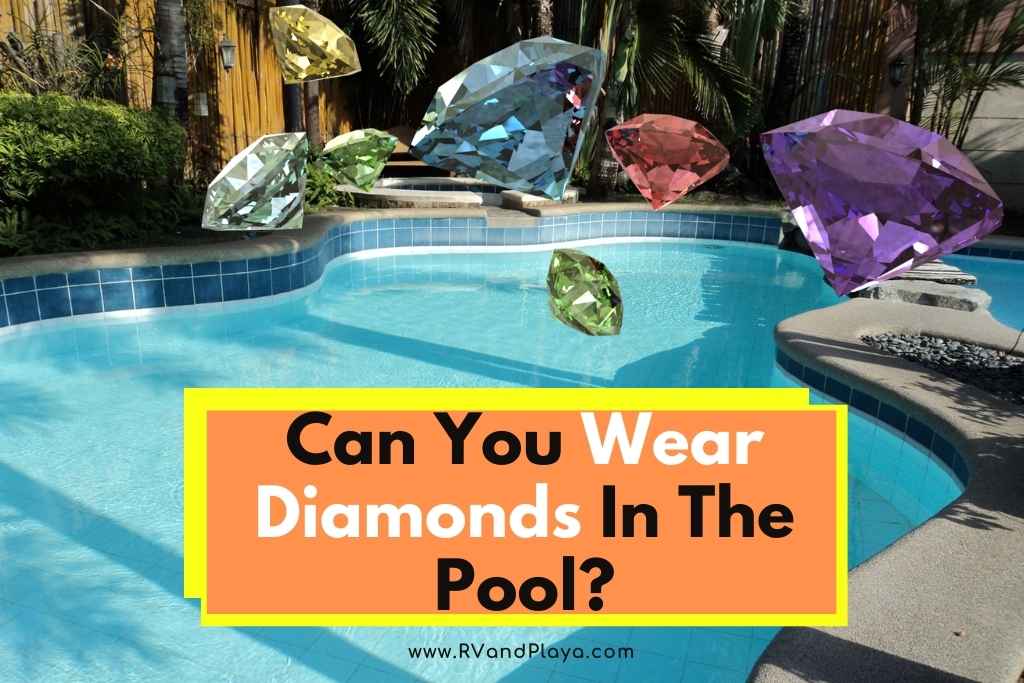Lindsey, do you know if I can wear diamonds in the pool? This is one of the questions our readers ask a lot. Well, we´ve got you covered.
If you’ve recently received a diamond engagement ring, you might find yourself wanting to never take it off, in case it gets lost or stolen. The sentiment is understandable, but sometimes wearing it may place your diamonds at even greater risk.
Experts of the jewelry industry recommend keeping your diamonds and other high quality jewelry away from the pool and other watery environments.
This article looks into whether or not your diamonds are safe in the pool, and what you need to watch out for if you go swimming in your jewelry.
Table of Contents
Can I Wear My Diamonds in the Pool?
If you ask a fashion expert, a professional jeweler, or a gemologist this question, you’ll get the same answer from all three:
Don’t wear your engagement ring or other diamond jewelry in the pool.
Exposure to the elements found in pool water, or most other aquatic activities – including showering and washing dishes – can result in your diamond losing its shine. It’s also possible to lose or damage your jewelry in various ways.
What Are Some Risks I Take If I Wear My Diamonds in the Pool?
- First and foremost, you run the risk of losing your diamonds.
Cold water can cause shrinkage of your hand – think of the ‘prune’ effect you’ll see after a while in the water – and allows loose or even not-so-loose items to slip out of place.
2. Chemicals can damage the stones and the settings both.
Gold alloys can be subject to corrosion, Diamonds or other gemstones that have undergone certain treatment processes may lose their shine and sparkle under the effects of highly chlorinated water.
3. Dirty stones and settings.
If you’re at the pool, you’ll probably want to do things like put on sunscreen. Sunscreen is an oily substance that can coat your ring and your diamonds, dulling them.
No matter how nice the pool, there are always little things lying around. Dust by the side of the pool, or similar small everyday contaminants that can be harder to get off a wet ring than a nice, clean dry one.
4. Damage to the stones and settings.
It’s not uncommon for you to lose track of what your hands are doing while enjoying a swim. Gold alloys are generally soft and easy to warp, break, or otherwise damage.
Damaged settings can result in loose or lost stones – expensive to fix and replace
Diamonds may be some of the hardest stones in existence, but that doesn’t mean they can’t lose some shine or take a little damage if continually or repeatedly abraded against the side of a pool.
Read also >> Can You Wear Diamonds in the Shower? (All You Need To Know)
Read also >> Why Is Graphite Softer Than Diamond? (All You Need To Know)
What Is The Most Common Problem I Might Encounter if I Wear My Diamonds In The Pool?
The most common – and most expensive, not to mention devastating – problem is the loss of the jewelry.
If you’re putting on sunscreen or other lotions, you may wind up inadvertently coating your diamonds with a slippery substance that can make it easier for a ring to slide loose.
Water, whether it’s chlorinated pool water or salty ocean water, is generally cooler. And even room temperature or warm water is likely to cause your hands to ‘prune’. This effect is brought about by shrinkage of tissues.
If your ring is at all loose, then it will become even more so as your fingers get ‘pruny’. That can make it all too easy for your jewelry to slip free and disappear into the depths.
- Save an Average of $350* on Lab-Created Diamonds
- James Allen is the leader in online diamond sales
Is This a Problem I Would Encounter With a Diamond Ring on a Necklace, or Other Diamond Jewelry?
While a necklace or bracelet is less likely to simply ‘slip free’, that doesn’t mean it can’t get lost.
Chemical Damage
Sometimes long exposure to water and chemicals, or salt, can damage the metal. If that happens, it may result in corrosion that causes the jewelry to develop weak spots that can break.
Impact of Drag
Swimming creates a certain amount of drag and friction, even in a relatively still indoor pool. In the ocean or an outdoor pool with more weather exposure, this can be even more noticeable.
Over time, this will augment stresses on weak links, leaving them to work loose and detach.
This can also affect the clasps of your jewelry. Over time, combined factors can cause the clasp to come loose, break, and lose the connection while you’re in the water
Wouldn’t I Notice If I Lost My Diamond Jewelry in the Pool?
There’s a good chance you would. However, there’s no guarantee, nor is there any guarantee that it will be found promptly or turned in to the appropriate location or people.
Even just swimming laps or doing light exercise tends to take concentration.
Most of us don’t think about things like jewelry when we’re swimming or playing around in the pool. Like anything else, it can be easy to get caught up in the activity and lose track of keeping an eye on jewelry.
Can Pool Water Really Damage My Diamond?
The water and chlorine in a pool are more likely to damage the setting and the metal of the band – or necklace, or bracelet – than the stone itself, but that doesn’t mean the diamond itself is safe from harm.
Most high quality jewelry is made of materials like silver, sterling silver, platinum, and gold – but it’s generally an alloy, rather than a pure metal because the pure metals are softer and tend to damage easily.
High karat gold or ‘pure’ silver and platinum (meaning that it’s over at least 75% precious metal) is generally able to handle chlorinated water, though you’ll have to clean it after each submersion if you want to keep it shiny.
Lower quality or lower karat metals are more likely to suffer from corrosion from the chlorinated water, which means they’ll wear out faster. They may also become discolored, or even turn your skin odd colors.
Can Chlorine Do Permanent Damage to The Actual Stones?
A good quality diamond is fairly tolerant of chlorine. However, that doesn’t mean it’s completely immune to chemical issues.
Unless you clean it well after each immersion in the pool, you’ll find the chlorine will adhere in small quantities to your diamond. This will result in your diamond taking on a cloudy appearance and losing its shine.
The same is true of salt water.
Depending on the quality of stone and where you purchased it, chlorine or other strong chemicals may also cause your stone to become discolored.
Why Would Chlorine Discolor My Diamond?
Many stones go through refining and treatment processes to enhance their color or reduce the impact of small inclusions or flaws.
Though this is more common with gemstones like emeralds, sapphires, or rubies, these processes are sometimes applied to lower quality diamonds as well.
Diamonds are most likely to be subjected to heat treatment, bleaching, irradiation, or filling treatments to enhance color and reduce the impact of any inclusions in the stones.
Most of the treatments are more or less permanent but can be impacted by chemicals in pool water.
Filling: Involves the application of liquid materials that harden to a transparent substance. Often used to reduce the visibility of inclusions or flaws in diamonds. Some of the substances used may react to pool chemicals.
Irradiation: Often used to produce colored diamonds with deeper color. Irradiation alters the molecular structure of the stone in subtle manners and can make it vulnerable to chemicals.
Heat Treating: As with irradiation, it’s often used to enhance luster and color, but it can alter the internal structure of the diamond in the process, resulting in conditions that may cause discolorations under harsh chemicals.
Bleaching: Bleaching uses chemicals to lighten the color of a stone. This is somewhat more common with other gemstones than diamonds. However, if your diamond has been subject to bleaching, further exposure may also cause further changes in the stone.
What Should I Do With My Diamonds If I Want to Go Swimming?
The best thing to do is take them off and leave them in a safe place, preferably in a jewelry case that can provide maximum protection.
If leaving them home isn’t possible for some reason, or if you forget to remove them before swimming, take time to clean them very carefully. This includes working a toothpick or other material under the prongs to get particles from between the stone, or stones, and settings.
If you’re not sure your ring is in the best of condition, or if you’ve been swimming with it for a while and noticed it’s taking damage, consult a licensed jeweler for a professional cleaning and an assessment to see if there are any negative effects from immersion in pool water.
References
https://www.brides.com/story/when-to-take-off-engagement-ring
Recent Posts
Whenever you wear diamonds daily, it can feel like a hassle to remove the jewelry before every shower and put them back on after. For this reason, many people wear their diamonds and luxury jewelry...
Do you know why graphite is softer than diamond? this is one of the questions our readers ask a lot. Well, we´ve got you covered. Graphite and diamonds are interesting minerals because they are...


